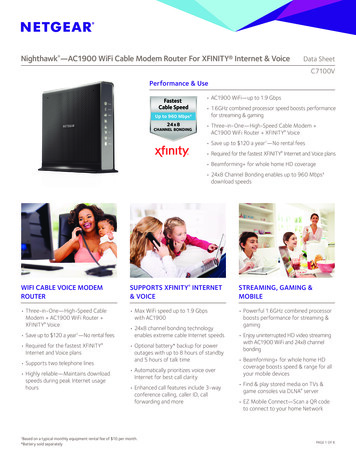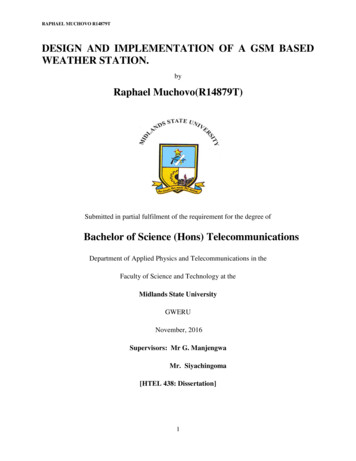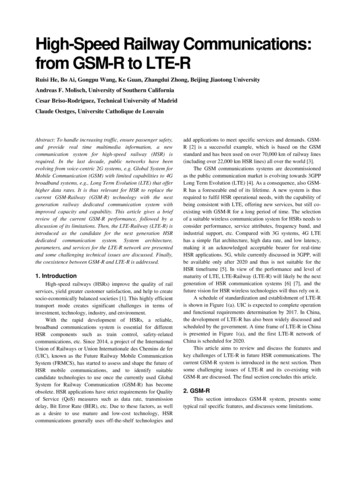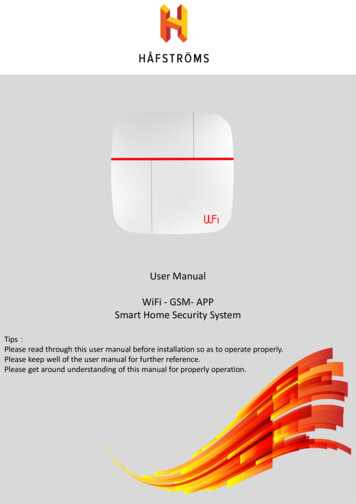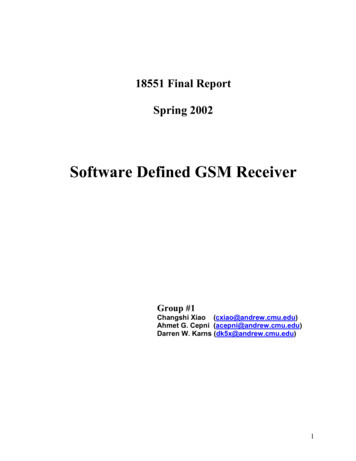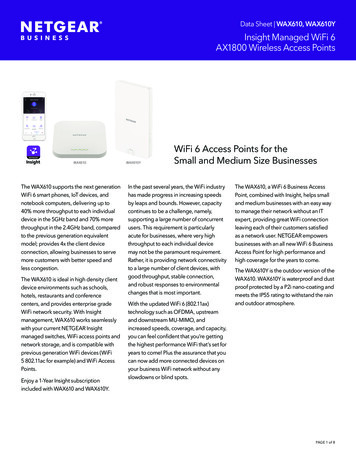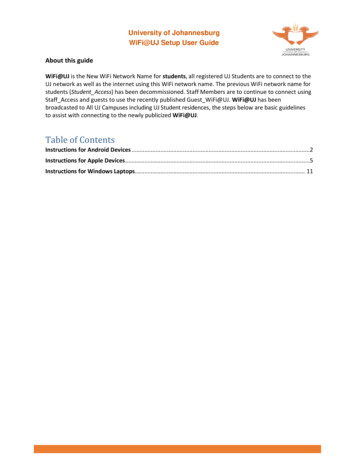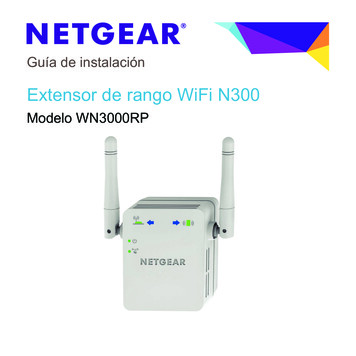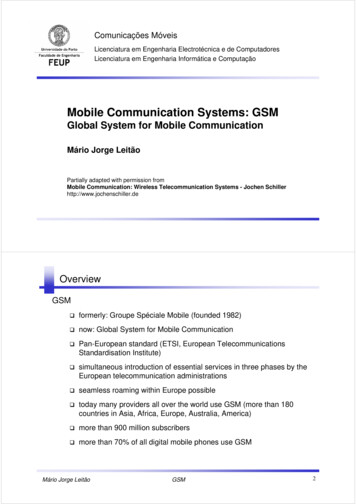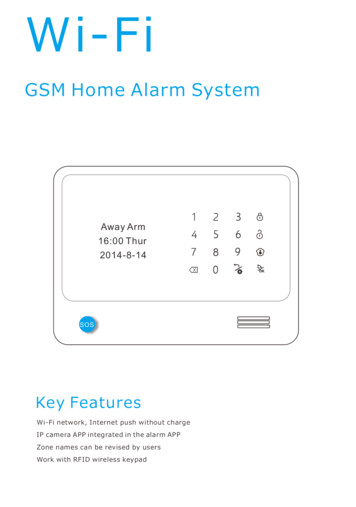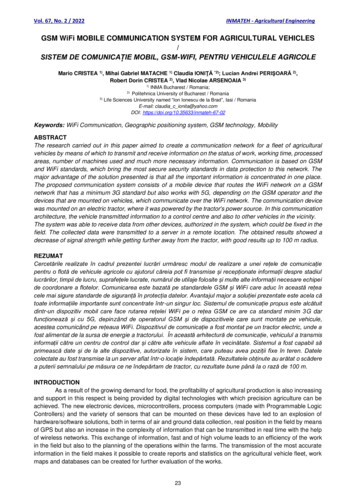
Transcription
Vol. 67, No. 2 / 2022INMATEH - Agricultural EngineeringGSM WiFi MOBILE COMMUNICATION SYSTEM FOR AGRICULTURAL VEHICLES/SISTEM DE COMUNICAȚIE MOBIL, GSM-WIFI, PENTRU VEHICULELE AGRICOLEMario CRISTEA 1), Mihai Gabriel MATACHE 1) Claudia IONIŢĂ *2); Lucian Andrei PERIŞOARĂ 2),Robert Dorin CRISTEA 2), Vlad Nicolae ARSENOAIA 3)1)INMA Bucharest / Romania;Politehnica University of Bucharest / Romania3)Life Sciences University named “Ion Ionescu de la Brad”, Iasi / RomaniaE-mail: claudia c ionita@yahoo.comDOI: https://doi.org/10.35633/inmateh-67-022)Keywords: WiFi Communication, Geographic positioning system, GSM technology, MobilityABSTRACTThe research carried out in this paper aimed to create a communication network for a fleet of agriculturalvehicles by means of which to transmit and receive information on the status of work, working time, processedareas, number of machines used and much more necessary information. Communication is based on GSMand WiFi standards, which bring the most secure security standards in data protection to this network. Themajor advantage of the solution presented is that all the important information is concentrated in one place.The proposed communication system consists of a mobile device that routes the WiFi network on a GSMnetwork that has a minimum 3G standard but also works with 5G, depending on the GSM operator and thedevices that are mounted on vehicles, which communicate over the WiFi network. The communication devicewas mounted on an electric tractor, where it was powered by the tractor's power source. In this communicationarchitecture, the vehicle transmitted information to a control centre and also to other vehicles in the vicinity.The system was able to receive data from other devices, authorized in the system, which could be fixed in thefield. The collected data were transmitted to a server in a remote location. The obtained results showed adecrease of signal strength while getting further away from the tractor, with good results up to 100 m radius.REZUMATCercetările realizate în cadrul prezentei lucrări urmăresc modul de realizare a unei rețele de comunicațiepentru o flotă de vehicule agricole cu ajutorul căreia pot fi transmise și recepționate informații despre stadiullucrărilor, timpii de lucru, suprafețele lucrate, numărul de utilaje folosite și multe alte informații necesare echipeide coordonare a flotelor. Comunicarea este bazată pe standardele GSM și WiFi care aduc în această rețeacele mai sigure standarde de siguranță în protecția datelor. Avantajul major a soluției prezentate este acela cătoate informațiile importante sunt concentrate într-un singur loc. Sistemul de comunicație propus este alcătuitdintr-un dispozitiv mobil care face rutarea rețelei WiFi pe o rețea GSM ce are ca standard minim 3G darfuncționează și cu 5G, depinzând de operatorul GSM și de dispozitivele care sunt montate pe vehicule,acestea comunicând pe rețeaua WiFi. Dispozitivul de comunicație a fost montat pe un tractor electric, unde afost alimentat de la sursa de energie a tractorului. În această arhitectură de comunicație, vehiculul a transmisinformații către un centru de control dar și către alte vehicule aflate în vecinătate. Sistemul a fost capabil săprimească date și de la alte dispozitive, autorizate în sistem, care puteau avea poziții fixe în teren. Datelecolectate au fost transmise la un server aflat într-o locație îndepărtată. Rezultatele obținute au arătat o scăderea puterii semnalului pe măsura ce ne îndepărtam de tractor, cu rezultate bune până la o rază de 100 m.INTRODUCTIONAs a result of the growing demand for food, the profitability of agricultural production is also increasingand support in this respect is being provided by digital technologies with which precision agriculture can beachieved. The new electronic devices, microcontrollers, process computers (made with Programmable LogicControllers) and the variety of sensors that can be mounted on these devices have led to an explosion ofhardware/software solutions, both in terms of air and ground data collection, real position in the field by meansof GPS but also an increase in the complexity of information that can be transmitted in real time with the helpof wireless networks. This exchange of information, fast and of high volume leads to an efficiency of the workin the field but also to the planning of the operations within the farms. The transmission of the most accurateinformation in the field makes it possible to create reports and statistics on the agricultural vehicle fleet, workmaps and databases can be created for further evaluation of the works.23
Vol. 67, No. 2 / 2022INMATEH - Agricultural EngineeringIn agriculture, different systems for collecting data about soil or air are used; they use WiFi withdifferent protocols, and the data obtained end up on a server or in the cloud to be processed. (Amine et al.,2022). The use of new technologies in agriculture allows the use of remote control technologies so that anincrease in efficiency and accuracy can be achieved in agricultural work, thus the management of resourcesis much simpler, also a number of automated systems, intended for routine work or for situations in whichhuman personnel are unable to intervene, can be achieved (Jinyuan et al., 2022).The literature describes the use of nodes and smart sensors that have low production costs. Thus,devices that allow creating irrigation systems at affordable prices that can be used by farmers were created.These devices are based on microcontrollers such as: Arduino Uno, Arduino Mega, Node MCU, WEMOS MiniD1, Raspberry Pi 2, Model B and Raspberry Pi 3 Model B . Also, the nodes thus designed can controlactuators or solenoid valves, used for opening and closing water circuits or for operating systems that havethe role of controlling the environment (Lloret et al., 2021).One of the problems with wireless networks is the disconnection, which leads to data loss or increasedtraffic as a result of packets of information that need to be resent. There are many studies that explain howradio connection interruption can be avoided or reduced by optimizing the transmission or communicationstrategies that minimize the time required for devices to transmit data over the network (Girolami et al. 2022).Mathematical algorithms can also be used to simulate data traffic in wireless networks to which the connectionalso depends on the connection time to allocate traffic so that the number of lost connections is as low aspossible (Ceselli et al., 2018).The microcontrollers used in such systems act as two-way communication with a command centrethat can be a PC or a WEB server running a database, such as MySQL, or on which is implemented a softwareintended for the communication with the sensors it is connected to. The sensors can use the serial bus withdifferent hardware configurations and protocols such as RS-232, RS-422, RS-423, I2C, ProfiBus and othersto communicate with the microcontroller.Modules for monitoring soil parameters have been developed with the help of low-costmicroprocessors and sensors; these modules can provide information about soil moisture and temperature.The modules use PIC16F877A microcontrollers, an LM 35 temperature sensor, a humidity sensor, a PIRsensor (passive infrared sensor) and a GSM module for communication. These modules have the advantageof very low cost, low maintenance and high reliability (Suma et al., 2017).There are projects that aim to develop embedded systems, which have support for radio, Wi-Fi,Bluetooth and GSM communications, which connect to a central node that has a very high capacity for datastorage and processing and the results or reports can be viewed in real time on any device with internet access(Julian et al., 2020).Concern for the development of low-consumption circuits and systems is present in all fields, researchin the field of electronics has increased the energy efficiency of electronic components. The development ofintelligent systems capable of fast communications and low energy consumption are factors that drive theimplementation of the concepts of Industrial IoT and Industry 4.0 (Sisinni et al., 2018).By using these integrated communication and data acquisition systems, farmers are able to assessthe soil profile themselves and thus they are able to plan future crops correctly. These systems are capable oftransmitting, generating reports and creating databases with fuel consumption, energy, tank fluid level, vehicleoperating hours, working time for the driver, travelled distance, speed (there are situations when speed is animportant factor), processed areas, harvested quantity, how to use the vehicle, errors and breakdowns thatoccur during operation.MATERIALS AND METHODSThe communication system is based on a mobile router (RBwAPR-2nD) that switches from GSM toWiFi. It contains a 650 Mhz Qualcomm Atheros QCA953 microprocessor, 64 Mb RAM and 16 Mb flash memory(https://mikrotik.com/product/RBwAPR-2nD).It connects all the devices needed to transmit to a control and monitoring centre. The data that aretransmitted depends on these devices and they are designed as to be chosen according to farmers’ needs.The router is designed as a mobile device, so the box in which it is mounted also contains a powersupply system based on a 12V battery. The device can be mounted on any agricultural vehicle, if it also has a12V power supply circuit which can power the router and even charge its battery. The block diagram of therouter is detailed in Fig. 1.24
Vol. 67, No. 2 / 2022INMATEH - Agricultural EngineeringFig. 1 - Block diagram of the mobile routerThe experiments were performed with the router mounted on a fully electric agricultural tractor. Thetractor was equipped with a Raspberry Pi 4 to which a GPS module, a video camera and a communicationmodule on the CAN bus were connected, with the help of which the microcontroller receives data on the batterystatus and the operation mode of the engine. The router is capable of handling up to 253 IP addresses. Thetransfer speed will be divided between all the devices that will be connected to the router so the modules thatare mounted in the field must be designed so that the data traffic through the router is within a reasonable limitso as not to reach the upper transfer speed limit of the router. Normally the volume of data through the routerwill not exceed 10-20 Mbs, a transfer speed also supported by the GSM network without being overloaded.The router used (4G LTE Secutron LS-1 External Modem) was developed by MikroTik, a companythat made both the hardware and the software. It is capable of a maximum transfer rate of 300 Mbs and thestandards accepted in the WiFi network are 802.11b / g / n.Table 1Secutron LS-1 wireless specifications (MikroTik, 2022)2.4 GHzTransmit (dBm)Receive Sensitivity 18-74MCS020-93MCS716-71The communication set consists of a wireless Access Point to which the GSM card is mounted anddepending on the operator it can transmit on 2G, 3G, or 4G. Another module to which another GSM card canbe mounted is used to remotely control the router using the predefined commands that are detailed in therouter’s manual. Figure 2 shows in detail how the circuits are located inside the protection box.Fig. 2 – Mounting of the Access Point and the remote control board in the box25
Vol. 67, No. 2 / 2022INMATEH - Agricultural EngineeringThe router was placed in the front part of the tractor next to the engine controller, see Fig. 3, so it wasprotected from water and dust, but since the signal may be attenuated by the hood which is made of metal,therefore it was also placed on the cab roof, see Fig. 4.Fig. 3 - Physical placing of the router in the tractorFig. 4 - Router placing on the tractor cabThe operating system of the router was RouterOS version 6.45.9, an operating system that can beinstalled on a PC and thus it can be turned into a router with all the necessary features - routing, firewall,bandwidth management, wireless access point, hotspot gateway, VPN server and more. The home page ofthe router is shown in Fig. 5.Fig. 5 - Home page when connecting to the routerRouterOS could be configured in a variety of ways, such as local access with keyboard and monitor,serial console with a terminal application, network access, and secure Telnet and SSH, using a custominterface (GUI) called Winbox, or a simple interface based on Web but also an Application ProgrammingInterface (API) for building custom control applications. If there is no local access or IP connection issues,26
Vol. 67, No. 2 / 2022INMATEH - Agricultural EngineeringRouterOS also supports a MAC connection by means of custom Mac-Telnet and Winbox programs. A part ofthe configuration menu is shown in Figs. 6, 7 and 8.RouterOS provides an integrated firewall that performs packet routing, IP address filtering, addressrange, port, port range, IP protocol, DSCP, supports static and dynamic address lists.Supported router protocols were: RIP v1 and v2, OSPF v2 and BGP v4 are supported for IPv4. RIPng, OSPFv3 and BGP are supported for IPv6.Fig. 6 - Interface configuration menuMost of the existing wireless technologies are currently supported in RouterOS, the main ones beingthe Access Point and the wireless client. It can be used both in small networks and at metropolitan level.Fig. 7 - WiFi configuration menuWireless protocol functions implemented in RouterOS: IEEE802.11a / b / g / n wireless client and access point Nstreme and Nstreme2 proprietary protocols Customer survey RTS / CTS Wireless Distribution System (WDS) Virtual AP WEP, WPA, WPA2 encryption Access control list Wireless client roaming WMM Wireless HWMP MESH protocol MME wireless routing protocolThe gateway allows providing access to the public network for customers who use wired or wirelessnetwork connections. Once a username and password are provided, the user will be allowed access to theinternet. No software installation or network configuration is required.RouterOS supports a large number of network tools needed to configure, monitor, or optimize thenetwork. Tools included in RouterOS are: Ping, traceroute Bandwidth test, ping flood Dynamic DNS updater VRRP redundancy support SNMP for providing graphs and stats27
Vol. 67, No. 2 / 2022INMATEH - Agricultural Engineering RADIUS client and server (User Manager) Telnet, SSH SMS send tools Packet sniffer Active connection table NTP Client and Server TFTP serverFig. 8 - Tools menuFrom the Tools menu, all router parameters are configured, modified or monitored. As can be seenin Fig. 8, the menu is well structured and, in each menu, when activated, a series of very intuitive submenusappear and they can be understood even by operators without much experience in this software.RouterOS configuration documentation is available on the manufacturer’s website and can beaccessed using https://mikrotik.com/software.The Raspberry microcontroller, Fig. 9, which was mounted on tractor board, uses a 7-inch displaywhile a wireless mouse and keyboard are used for programming.Fig. 9 - Raspberry Pi 4The operating system used on the Raspberry Pi was Raspberry Pi OS, installed on a 16Gb SD card.Raspberry connected to the mobile router to transmit pre-programmed data to a website is shown inFig. 10.Fig. 10 - GPS position displayed by Raspberry PI28
Vol. 67, No. 2 / 2022INMATEH - Agricultural EngineeringTransmitted data represented the GPS position of the tractor in the field, technical indicators of theelectric propulsion system or of the equipment that is coupled to the tractor, the battery power level, theestimated operating time and the use of the tractor, as shown in Fig. 11. An example of visualization in googlemaps is presented in Fig. 12.Fig. 11 - Data sent by the engine controller to the Raspberry Pi via the CAN busFig. 12 - Use of GPS coordinates to display one’s position on Google Mapswith the Raspberry Pi microcontroller mounted on tractor boardFig. 13 shows that when the tractor is in motion, all devices that are located in the field and have theability to connect to a WiFi network, supported by the router, connect to the router as they manage to establisha stable connection and thus these devices can transmit information from connected sensors but may alsoreceive data packets that may contain configuration or command information from a dedicated server.Fig. 13 - Way of connecting devices to the router and to the internet29
Vol. 67, No. 2 / 2022INMATEH - Agricultural EngineeringSuch a mobile router can provide coverage of approximately 31,400 square meters. If the devicesfixed in the ground are on a larger surface, it is necessary to increase the number of routers so that thecoverage is maximum.RESULTSThe results of the signal level measurement were performed using a mobile phone that was connectedto the router. The latter was able to indicate the level of signal provided to any device that was connected toit. The signal level was displayed by the router itself, as illustrated in Fig. 14.Fig. 14 - Signal level with the router connected to a single deviceThe measurements were made in a straight line with the tractor on a flat surface without obstaclesbetween the router and the connected device. The following table shows the signal values between the routerand the device and are displayed using the software implemented in the router.Table 2Distance (m)10m15m25m50m100mMeasured value (dB)Engine compartment, front-69-73-81-83-84Engine compartment, left and right side-70-72-82-83-86Engine compartment, rear-74-79-82-83-86Front roof-64-68-69-79-85Side roof (left/right)-63-75-67-80-87Rear roof-59-59-63-65-82The router has the ability to provide traffic information for each connected device. This can be helpfulwhen calculating the amount of data traffic required for existing devices in the field.Fig. 15 and 16 show how the network signal decreases as one moves away from the router.Fig. 15 - Signal level measured at the front and rear of the tractor (dB)30
Vol. 67, No. 2 / 2022INMATEH - Agricultural EngineeringFig. 16 - Signal level measured at the front and rear of the tractor (roof, dB)The data transfer rate of the router is limited by the transfer rate provided by the GSM service providerin the area where the router operates.Below is shown the router traffic without a GSM internet connection (Fig. 17). It is only the traffic that isgenerated in the WiFi network between the connected devices and the router.Fig. 17 - Real-time data traffic report with no internet connectionThe data transfer to the internet depends a lot on the GSM service provider. The router is capable of atheoretical GSM transfer speed that can exceed 200 Mbps.It is found that when the router is mounted in front, inside the engine compartment, although it is moreprotected from solar radiation or precipitation, the hood acts as an electromagnetic shield and thus the rangeof the router decreases.Indoor antennas were used, mounted in the protection box of the router, but in order to increase therange of the router, external antennas could be mounted with an increased signal gain.CONCLUSIONSThe communication system proposed could be used as a mobile relay that connects to the internetthe devices that communicate in the WiFi network but also as a fixed relay for devices mounted in the field.The area covered is large enough to be used by a relatively large number of agricultural vehicles to transmitinformation that is considered useful in real time to a web server or cloud service.When used on an agricultural vehicle, the power is supplied from the vehicle system, 12V, but it alsohas a battery to be used even if the vehicle has been stopped. Battery life is 5 days with 22 hours of operationper day.The device can be used with solar power to increase the autonomy of operation. When it is used asa fixed access point and is powered by a solar station, the usage time can reach from a few months to even afew years without maintenance.31
Vol. 67, No. 2 / 2022INMATEH - Agricultural EngineeringThe usefulness of such a device can be highlighted especially on agricultural areas located in placeswhere the internet connection is difficult or requires large investments in communication infrastructure.ACKNOWLEDGEMENTThis work was supported by a grant of the Romanian Ministry of Education and Research, CCCDI UEFISCDI, project number PN-III-P2-2.1-PED-2019-2862, contract 483PED, project name: RemoteMonitoring System for Electric Vehicles using IoT Technologies, within PNCDI III.REFERENCES[1]Amine F., Mohamed S., Essaid S. (2021). An Agile AI and IoT-Augmented Smart Farming: A CostEffective Cognitive Weather Station. Agriculture. MDPI, Agriculture 2022, Switzerland, ]Ceselli A., Fiore M., Premoli M., Secci S. (2018). Optimized assignment patterns in Mobile Edge Cloudnetworks. Computers and Operations Research, Volume 106, pp. 246-259. DOI:10.1016/j.cor.2018.02.022[3]Girolami M., Vitello P., Capponi A., Fiandrino C., Foschini L., Bellavista P., (2022). A mobility-baseddeployment strategy for edge data centres. Journal of Parallel and Distributed Computing, Volume 164,pp. 133 - 141. DOI: 10.1016/j.jpdc.2022.03.007[4]Lloret J., Sendra S., Garcia-Fernandez J., Garcia L. and Jimenez J. (2021). A WiFi-Based SensorNetwork for Flood Irrigation Control in Agriculture. MDPI, Electronics 2021, 10(20), ]Jinyuan X., Baoxing G., Guangzhao T. (2022). Review of agricultural IoT technology. ArtificialIntelligence in Agriculture, Volume 6, pp. 10-22. n J. M., Orosco E. C., Soria C. M. (2020). Multi-Sensor Embedded System with MultipleCommunications Based on EDU-CIAA. IEEE Latin America Transactions, volume 18, Issue 2, pp. 368- 375. DOI 10.1109/TLA.2020.9085292[7]Sisinni E., Saifullah A., Han S., Jennehag U. (2018). Industrial internet of things: Challenges,opportunities, and directions. IEEE Transactions on Industrial Informatics, Volume 14, Issue 11, pp.4724 – 4734, Article number 8401919. DOI: 10.1109/TII.2018.2852491[8]Suma N., Samson S., Saranya S., Shanmugapriya G., Subhashri R. (2017). IOT Based SmartAgriculture Monitoring System. International Journal on Recent and Innovation Trends in Computingand Communication, p. 5. DOI: 10.35940/ijitee.i7142.079920[9]*** MikroTik, https://mikrotik.com/[10] *** TP-Link Technologies Co., Ltd., www.tp-link.com/us/32
Vol. 67, No. 2 / 2022 INMATEH - Agricultural Engineering 23 GSM WiFi MOBILE COMMUNICATION SYSTEM FOR AGRICULTURAL VEHICLES / SISTEM DE COMUNICAȚIE MOBIL, GSM-WIFI, PENTRU VEHICULELE AGRICOLE Mario CRISTEA 1), Mihai Gabriel MATACHE 1) Claudia IONIŢĂ *2); Lucian Andrei PERIŞOARĂ 2), Robert Dorin CRISTEA 2), Vlad Nicolae ARSENOAIA 3) 1) INMA Bucharest / Romania;
